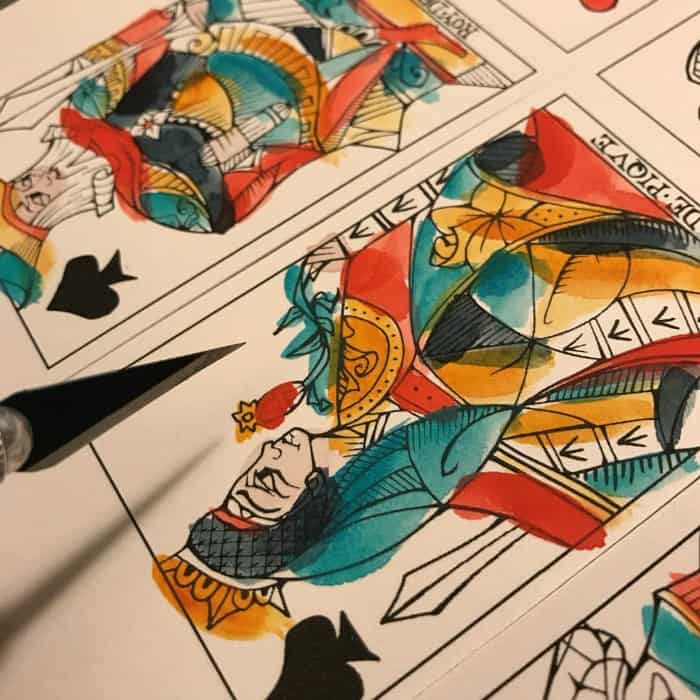
This week, I dropped a post about my writing process. I’ve had a lot of people ask about it so it made good sense to share it. Although writing is my creative outlet, I find myself endlessly fascinated with artists. Especially tarot artists.
Where do they get their inspiration? What is their process for creating? What impact do they want to make with their work?
I decided to find out. I reached out to some of the hottest new tarot deck creators out there: Ryan Edward, Bronwyn Walls and Aleisha Fitz of Mesquite Tarot, Courtney Alexander, and Michael Bridge-Dickson. Here are their answers.
Ryan Edward of Maybe Lenormand
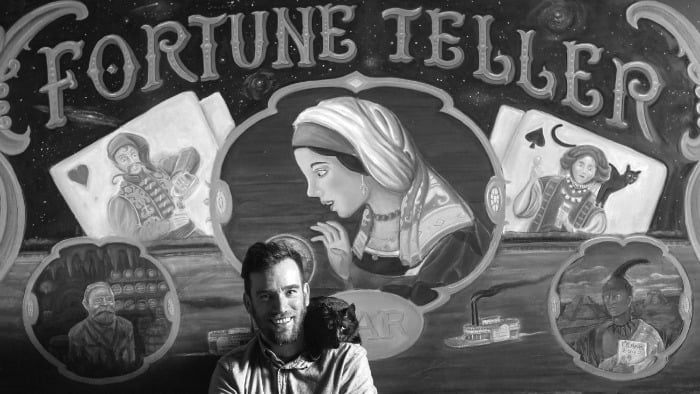
Ryan Edward is a dear friend and an amazing artist. I feel grateful to know him. His work is incredible and he’s one of the sweetest people on the planet! I have the Maybe Lenormand and am currently covering his Marseilles deck.
Bio:
Always curious, Ryan Edward is a designer from St. Louis. He has turned his passion to cartomancy and card reading, both using cards to inspire creativity and recycling that creativity to make cards. Ryan designed Maybe Lenormand, a simple, easy-to-use deck, with clean illustrations that evoke the cards’ function. As a bonus, there are 16 extra cards that are traditional in fortune telling packs, for 52 cards in total. Available as a hand-painted limited edition, or from US Games He’s currently working on Playing Marseille, a cross between the Tarot de Marseille and playing cards. Currently available as a hand-painted limited edition, with a standard edition planned for the near future.
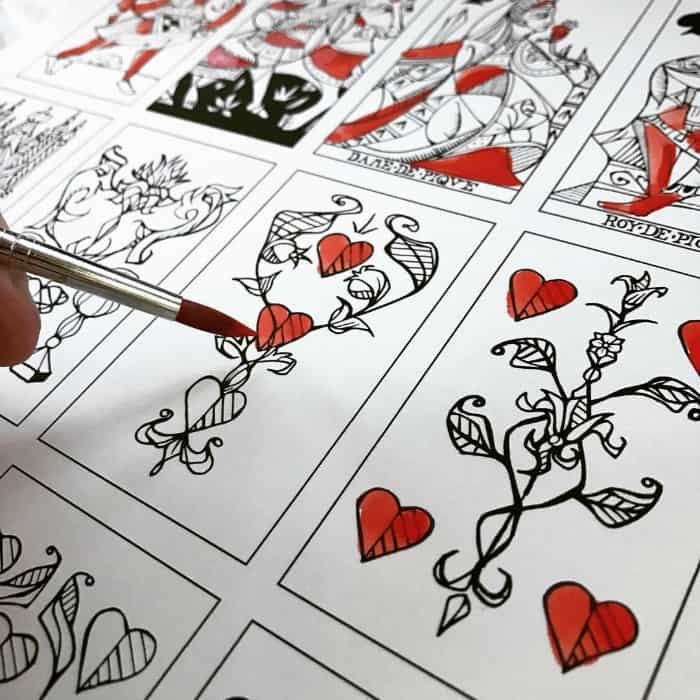
Q: Where do you get your creative inspiration?
Ryan: Is it a cliché to says ‘everywhere?’ I love cards, old cards. They way there were drafted and crafted turns me on. So I like etching and woodblock, styles that derive from their medium. I also love lots of bits throughout the 20th century, mid-century cubism, outrageous 1970s type and illustration, and minimal 1960s swiss posters. The spectrum ranges from minimalism to brutalism. I also love plants, so there’s always a draw to organic or floral work.
Q: What is your process for taking an idea and turning it into a real product?
Ryan: Start developing ten or more ideas, one or two will stand out and gain your passion and focus, produce those. Draft, test, revise, and test again. Hardly anything is brilliant right out of the gate, things evolve iteratively. If you can, have peers review your work before launch, with time for edits. Create prototypes, test, read, work with a prototype. Things looks good on paper, or as a proof, but a tangible, in hand version will give you something to scrutinize for the better. If we’re talking decks, FORM FOLLOWS FUNCTION. It’s the most basic of design principals, but not paid attention enough IMHO. Cards can be pretty, but do they read well? Signing with a publisher, or going independent both have their benefits. I had the benefit launching my first deck both ways. If you find a publisher that thinks you’re a fit, trust them. If you go independent, buckle up. The rest should be a given. Promote, connect, be thankful to *anybody* who supports your work. Wash, rinse, repeat.
Q: What kind of impact would you like your tarot deck to make?
Ryan: To remind people that we all read playing cards. 32 or 78, everything from the French Pique and Lenormand to the standard poker deck and Tarot, most decks we read with were original made for games. They’re all related.
Q: How has tarot impacted your world?
Ryan: It’s provided endless inspiration.
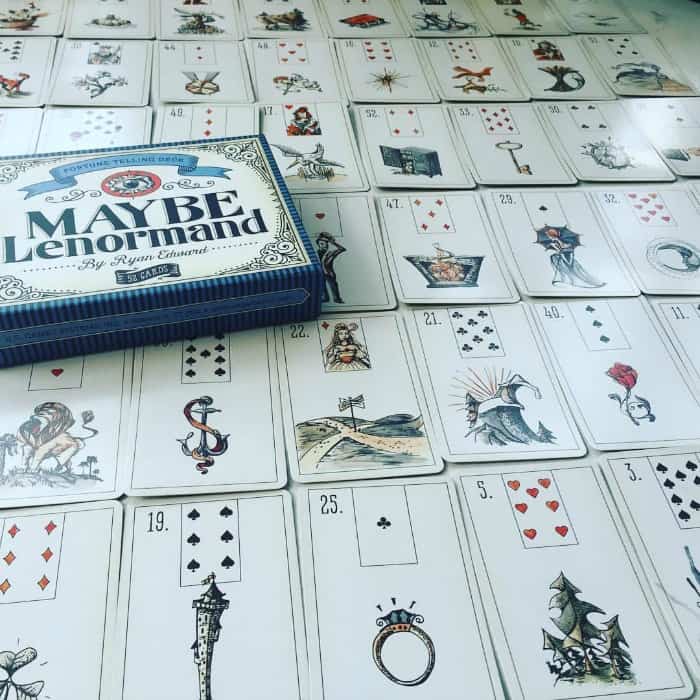
Bronwyn Walls and Aleisha Fitz of Mesquite Tarot
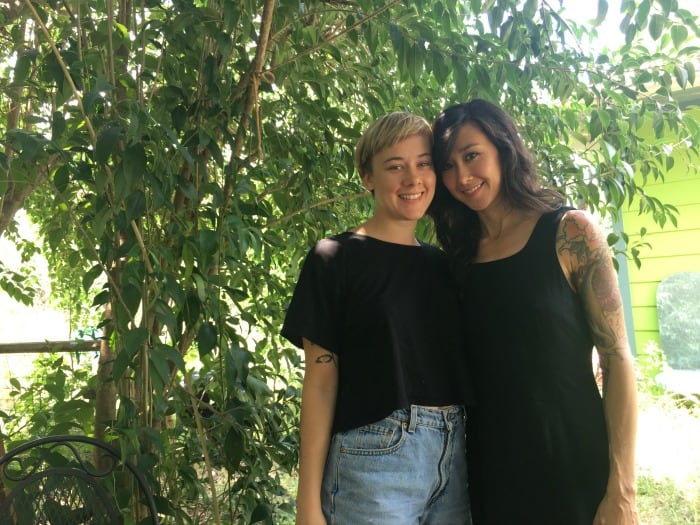
I first learned of the Mesquite Tarot through their Kickstarter campaign. The simple artwork drew me in and I’m now eagerly awaiting my copy.
Bio:
Bronwyn Walls and Aleisha Fitz are a pair of creatives living in Austin, Texas. Bronwyn is an illustrator and visual artist who approaches her work with intention, emotionality, and intuition. She uses simplistic designs to hold power and communicate perspective. Aleisha is a maker and writer who is fond of being barefoot outdoors, getting lost in words and woods, and creating objects and spaces that bring comfort. Collectively, their interest and education in Psychology, English, and Art created the perfect climate for tarot exploration.
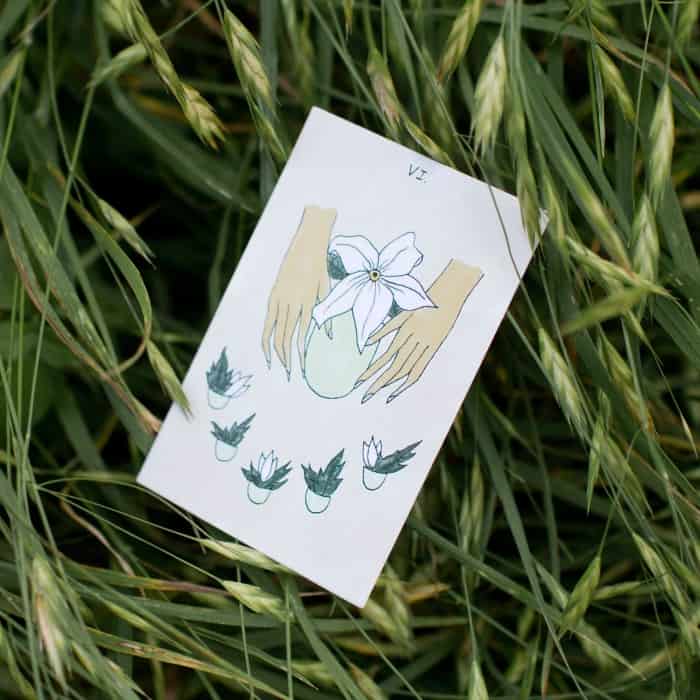
About the upcoming Mesquite Tarot in the artist’s own words: Mesquite is a soft and simple approach to tarot. Our deck and guidebook offer a gentle space to begin or deepen your tarot practice. Mesquite emphasizes the inward process, cultivating honesty, connecting with intuition. We want Mesquite to appeal to people who might find tarot intimidating or dense, people who might not relate to the more traditional imagery of the tarot. Our visual approach is soft and simple and our interpretations communicate meaning holistically. Mesquite tarot is about connection: to nature, to the self, and to others. We feel fostering this energy of clarity is really important and we hope it will be a tool for expansion and growth.
Q: Where do you get your creative inspiration?
Bronwyn and Aleisha: Much of our inspiration comes from nature, our connection to the flow of the world and finding our space within it. We’re fascinated by exploring our internal worlds and the unseen mysteries all around us. For us, inspiration tends to show up when we slow down, feel silence, take the time to connect and be present.
Q: What is your process for taking an idea and turning it into a real product?
Bronwyn and Aleisha: It can be super overwhelming to have an idea spark and then consider all the necessary steps involved in getting to the end result. We try to remind ourselves that we just have to start somewhere, take one step at a time, know that it will all unfold in time.
For this project, we’ve spent time talking about each card together, fleshing out our understanding and intuitive connection, using the resources we have to find ways to communicate that in an inviting way. It can be difficult to maintain a balance of creative connection and organization/maintenance of the less exciting aspects of making (like budgeting, marketing, etc.). We’re still learning so much. In the creative process, these balances are always in flux, never still. We’ve found the best way to learn is by doing— so many lessons exist in the process.
Q: What kind of impact would you like your tarot deck to make?
Bronwyn and Aleisha: Most of all, we hope that Mesquite will create a space for people to better understand themselves and the world. We want it to be a tool for integration and creating clarity, connecting to the intuition and knowingness within each of us.
We hope that Mesquite practitioners might see themselves with compassion and go on to extend that same understanding to others.
Q: How has tarot impacted your world?
Bronwyn and Aleisha: One of our favorite aspects of tarot is that it continues to deepen and evolve as we do; it’s an ever-growing tool. Like many others, we starting using tarot out of curiosity. When we felt connections and understandings spark within us, our relationship with the cards developed into a daily practice. We’ve noticed we’re able to be more present with our emotions, more aware of how we’re reacting to energies at play at any given time and have a broader perspective on our situation. Tarot has also been a powerful connector— it’s created space to deepen relationships and have a template to communicate about specific ideas and qualities that are a part of everyone’s experience. In creating our deck & guidebook, we’ve grown a lot as creators. It’s pushed us to expand both as practitioners and as artists.
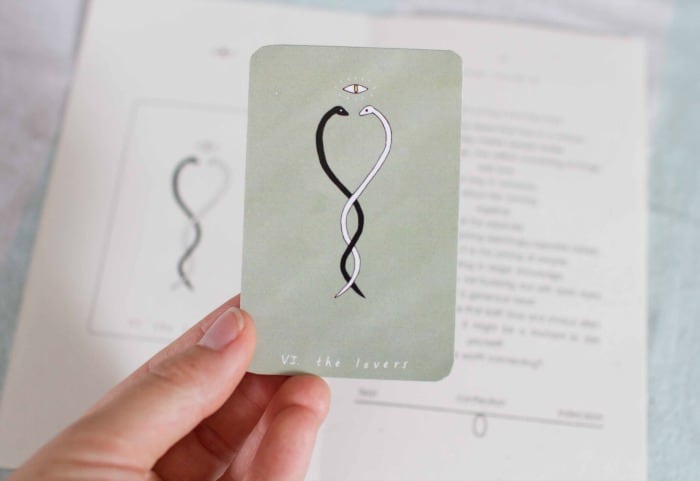
Courtney Alexander of Dust II Onyx
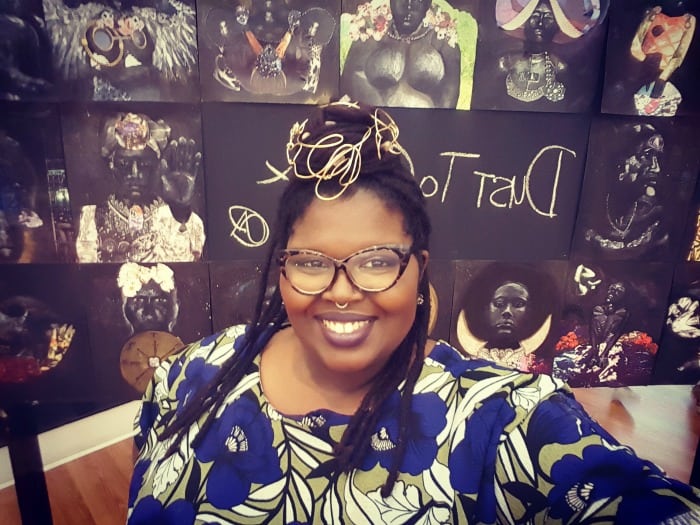
Courtney Alexander is due to deliver the most anticipated tarot deck, ever. Dust II Onyx is on everyone’s lips and wait list. This one promises to be a must have for every tarot fanatic.
Bio:
Courtney Alexander is a recent graduate with her Bachelor’s in Studio Art from the University of South Florida. In her past work she dug into issues of duality, hyper sexuality, and self-awareness; a much more personal dialogue which served to create vulnerability and explore the complex nature of her existence. Her paintings and sculptures are abstract and experimental, allowing for a more tactile sensory experience. The Dust II Onyx Tarot Deck is a natural progression in her exploration of identity and her largest project to date.
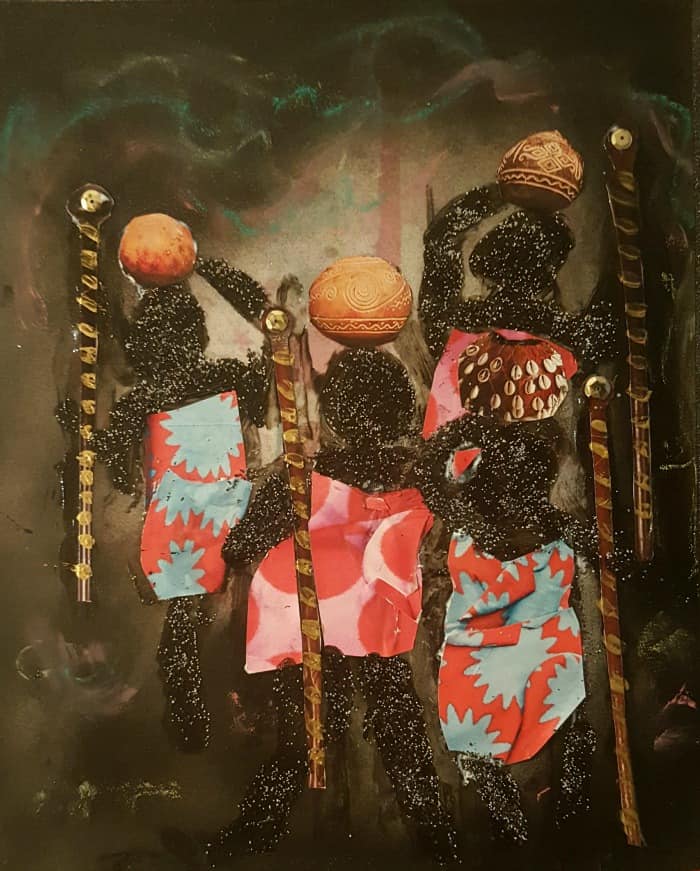
Because Courtney is knee deep in writing the book for Dust II Onyx, we thought it would be easier (and more fun!) to do a quick audio interview. If you prefer to read her answers, I’ve got a transcript too!
Recording:
Transcript:
00:00 Theresa Reed: Today, I am so excited to be talking to Courtney Alexander. Courtney Alexander is the artist behind one of the most anticipated tarot decks that’s due to arrive soon. It’s the Dust II Onyx Tarot, this is one that has so much buzz about it. And I love everything about tarot, but also about art. And so I’m excited to talk with Courtney today all about creating this deck. Courtney, welcome. Thank you so much for being here.
00:33 Courtney Alexander: Thank you for having me.
00:36 TR: Like I said, I really love everything about art, because I always say I’m graphically challenged. So, I also admire artists and the way they work, the way they think. So the first question I wanna ask you is, where do you get your creative inspiration?
00:51 CA: From multiple different places. Well, I graduated with my degree in studio art, so over the past few years, I’ve definitely been exposed a lot more to the art world, and contemporary art. And having my understanding of what it means to be a creative person, challenged and pushed. So, I definitely look to others artists, especially in the contemporary art world, to inspire me and help me to kind of challenge the way that I… ‘Cause I came from a graphic design background, so to get out of this project-minded state of mind that I was in to actually taking chances and taking risks in the way that I create. Of course, I also look to myself and my views on society and identity and all these other things that I’m interested in, to kind of feel my work and help me process the way… The lens that I see the world through, essentially.
01:47 TR: Awesome. So, let’s talk about your process. What is your process for taking an idea and turning it into a real product?
01:55 CA: Usually I just, of course, start out with a basic idea. And I’m a research-oriented person, I think it’s the Virgo in me. [laughter] So being very detail-oriented, I like to kind of see what’s out there, see what’s been done already. Especially if I decide I want to bring something special and unique to the process. For this tarot deck, a lot of the artwork, whenever… The archetype is already set up, so a lot of the times I will start researching those archetype in terms of for me this is my… I probably see… I’m sorry, I’m getting all mixed up. The lens that I view this black culture through, so I began to just research different traditional African cultures and traditions, understanding modern black culture and just doing the research based on the archetypes that I was referencing in. So for the artwork, for the deck, I definitely had imagery that I looked to and I also learned so much about new traditions that I had no awareness of, but fit right in with the meaning and the idea of the deck. And just some of them were great analogies for life. So that was my process for the deck and how I generally work through any project.
03:18 TR: Right on. You know, I write, I don’t do art. And for me, for writing, it’s always like you get an idea, you gotta toss that idea, you gotta research the idea, so I know the research part. And then I like to just spill it all out and then pull back, and then go back and look at, “Okay, how do I simplify, how do I clean this up? How do I put it together now, so it feels congruent and makes sense for me?” So it’s kind of like my process is messy as it can be, just for writing.
03:48 CA: Yeah. And that’s how it is for me with art. Art is so much easier for me to just be like, “Okay, I’ve kind of taken in everything that I could, so now I gotta ring it out on the canvas and see what happens.” And it’s a very intuitive process for me. The challenge is writing because writing, I just have to force myself to not perfect everything when it hits the paper. So just kinda having that freedom to just let things flow is a bit more challenging on the writing end.
04:21 TR: Isn’t that funny, I find it to be the opposite with like art is for me, I do the same thing with art. When it comes to words, I just let that stuff spill and then go clean it up, and I try not to edit it. So I find that really fascinating, because, if you put a paper in front of me, oh, my God, I take forever to even get a pen to the paper. It’s pretty sad.
[laughter]
04:42 CA: I understand. Definitely.
04:46 TR: So, let’s go and talk about tarot. What kind of impact would you like your Dust II Onyx Tarot to make?
04:54 CA: For me, my main goal and intent is healing, especially for black people. The deck can be used and anybody can gain something from the deck. It doesn’t matter what your race or religion or your background is. Everybody who has access to the deck and resonates with it can use it. But in regards to who I have in mind and in my heart when I created the artwork, it is black people and the black community. Because being in the metaphysical world over the past couple of years and experiencing first hand that disconnect sometimes, it’s important to not just see yourself represented in cards by skin color. So there are some decks that feature brown skin people, but to also have that representation by the creator who you… Because your soul goes into the work.
05:50 CA: So my soul, my experiences, my understanding of being a black woman, all of that is going into the deck, and that gives a totally different experience than someone who may just be inserting the characters. Like I said, just as a means of diversity. And so, that’s why, again, going back to just the healing and transformation aspect. Once people of color who have not felt that they had a place in tarot, see that there’s a deck out there for them, by a creator that understands them. That can open up a whole new aspect of their life, in the same way that tarot did for me.
06:31 TR: Absolutely. And I think it’s really brilliant and it’s time has come, because too many decks are really there’s like an absence of decks with people of color. So if you look through most of the decks out there, there are decks that do have brown people in them but just not enough. It’s not enough. So, I think this deck is going to be very important. I think it’s gonna strike a cord and it’s gonna bring more people in. It feels so inclusive and that’s the thing. It’s going to bring people in to tarot and I think it’s really brilliant that you’re doing this.
07:07 CA: Thank you.
07:08 TR: So our last question. How is tarot impacted your world?
07:15 CA: Well, it has impacted it a lot, [chuckle] as you can see. It’s just kind of been an amazing journey with tarot, because I never thought that I’ll have this relationship with tarot, in the way that I do now. Because growing up in a traditionally Christian family, and watching John Hagee on TV talk about how evil tarot was and he had to like do an exorcism on a woman who used the cards. I have this really innate fear of it for a long time. Even though I started going to people who are clairvoyant, I never wanted them to use cards, that would always turn me off. For me, started using the apps and slowly worked my way into it and I started understanding it worked for me, with my little Virgo minds and attention to details, like I love reading patterns. And once I realized that tarot was a tool to kind of help me process what’s already within me. Because that’s all tarot really does, is it’s just drawing out what is already there. We’re intuitive, we already have this connection. It’s not opening up a new portal, it’s just making, it’s just kind of making sense of everything.
08:27 CA: So, once I begin to really try and understand the cards and read for myself and I purchased my first deck and everything. It just, everything clicked. And so I was doing readings for myself and just readings for a couple of close friends and realizing like, “Oh, wow, I kinda have a gift with this that I didn’t realize that I had either.” And I still don’t charge people for tarot readings or anything. It’s something that I take very seriously in regards to doing that, so I haven’t felt ready to make that jump. But just even the experience with people close to me has made me feel more empowered and has taught me to trust myself. And the same way that I’ve learned to look for patterns and new understanding through tarot is kind of reflected in my life. And seeing the same thing when I go out, and see symbolism and I see other things that now I just don’t take for granted. Everything, to me, the smallest thing can be a message. I try to not be that person and be like, “Oh there’s a leaf on the sidewalk, I wonder what that means?” [chuckle]
09:32 CA: Like I don’t want to be that person. But yeah, when something sticks out to me and when something feels meaningful, to trust that feeling and to go with it. So, tarot has been a trust-building process with myself and I’m really thankful to have it in my life now. And I’m really thankful too, in regards to, how tarot has helped me improve my art because sometimes I’m just as surprised at the cards as everybody else. Sometimes I look at them I’m like, “I can’t believe that this came from me.” So, tarot has truly been a gift in my life.
10:07 TR: Well, that’s wonderful and I think the Dust II Onyx tarot deck is going to be an incredible and important gift to the tarot community. So, I wanna thank you for creating it and I cannot wait to see the finished product.
10:23 CA: Thank you. I can’t wait [chuckle] to see it either.
10:26 TR: Yeah, it’s gonna be quite exciting for you.
10:28 CA: Yeah, yeah. It’s so surreal but I’m excited. I feel like this is what my life has been building up to in a way. [chuckle]
10:40 TR: Right on. It’s going to be amazing. And so for everybody who is listening, first of all, you can find the deck at dust2onyx.com and that’s D-U-S-T-2-O-N-Y-X.com. So, get there, get in the know, keep an eye, the deck will be coming out soon. And it’s gonna be one that you’re gonna want to have in your tarot collection, it’s phenomenal. And Courtney, thank you so much for taking the time to chat with me about your creative process in tarot.
11:09 CA: Thank you for having me, Theresa.
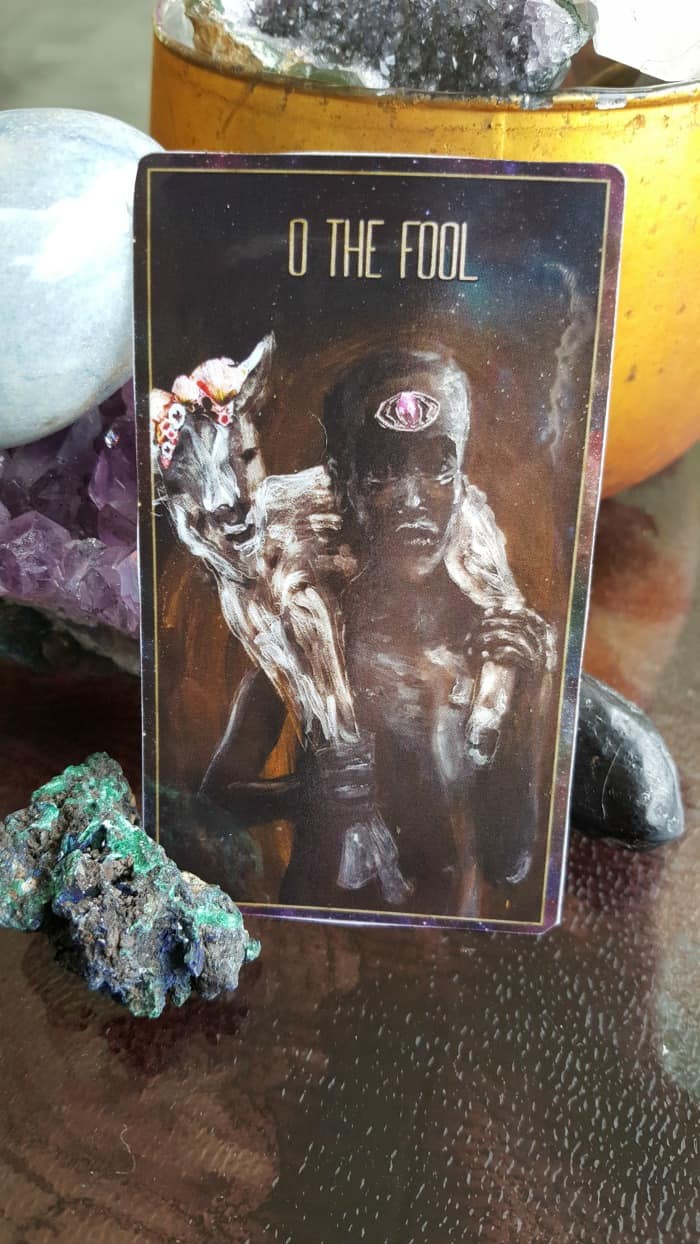
Micheal Bridge Dickson of Oribold Tarot
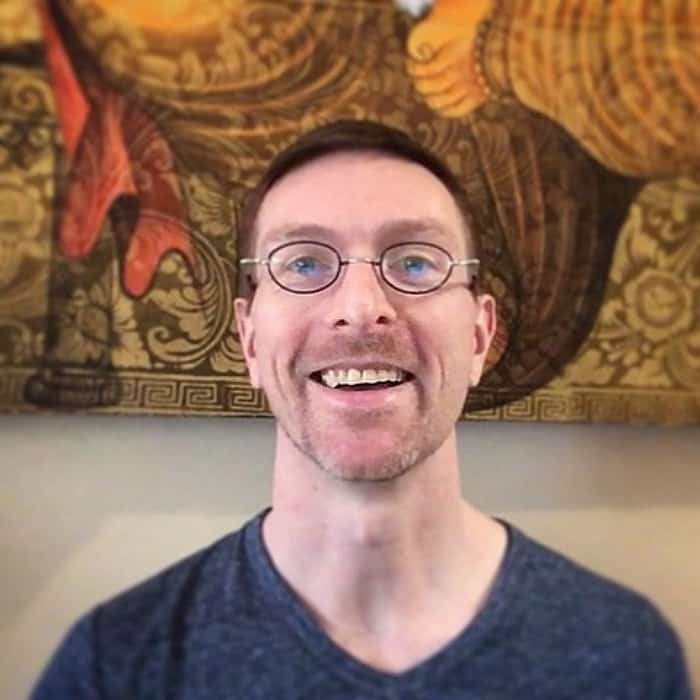
I met Michael Bridge-Dickson at a tarot conference a few years ago. He’s a fellow yogi so of course, I liked him right away! He’s also the creator of one of the most unique tarot decks, the gorgeous Orbifold Tarot.
Bio:
Michael Bridge-Dickson is a tarot reader, yoga instructor, graphic artist, and writer living in Montreal, Canada. He is also the creator of the award-winning Orbifold Tarot, and upcoming Arcanum X Tarot. His interest in both tarot and yoga is in helping people discover the intrinsic connections between the inner self and outer interactions. You can learn more about Michael by visiting his blog Mirrors of Consciousness or his YouTube channel.
The Orbifold Tarot is a beautiful exploration of life’s endlessly changing cycles. Each card represents rhythm, balance, and pattern through the simplest of forms — the circle. With this form, the Orbifold Tarot expresses tarot’s essence of Number and Element in a minimal and elegant design. The Orbifold Tarot can be purchased at http://www.orbifoldtarot.com/purchase.html
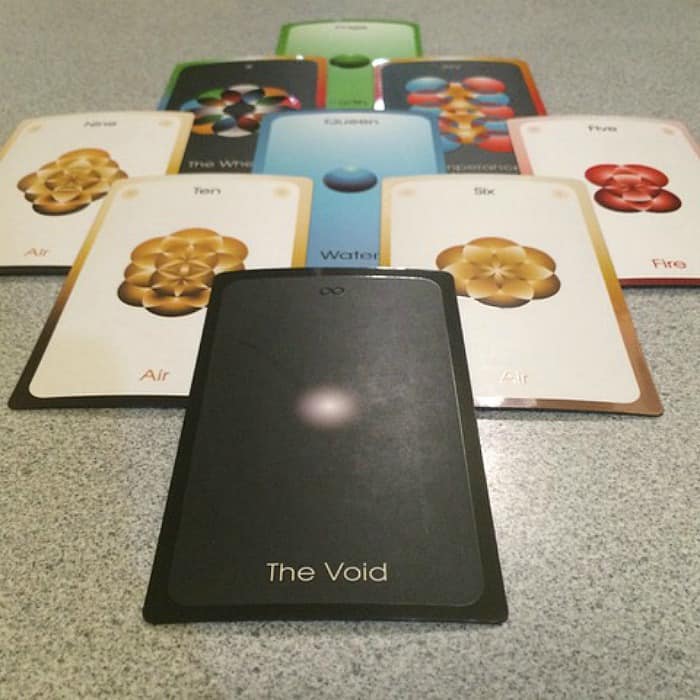
Q: Where do you get your creative inspiration?
Michael: I get inspiration wherever I can, honestly! Sometimes it is something very intangible: a mood or a feeling, a word or concept; and other times it is something more concrete: a color combination, a shape or object, an image, or an event. Sometimes I’m also inspired by a medium — I’m currently fascinated by watercolor and have a project I want to work on after Arcanum X. When I was in fashion and costume design I would often get inspired by a fabric: my closets are littered with fabrics I’ve bought thinking, “I know EXACTLY what to make out of THIS!”
Often I find that the best creative endeavors draw from and combine several of these sources.
Q: What is your process for taking an idea and turning it into a real product?
Michael: Despite finding inspiration from as many sources as I can, I will say that for me, it usually starts with an idea, a word, or concept. I then start to do visual research: I try to take photos in my environment, turning my eye toward things that have a look that I’m after or that communicate my concept in various ways. If I don’t find that kind of visual stimulation in my environment, then I will turn to books or online image searches. At that point, it’s more about seeing what other artists are doing so that I can both stay current, but also try not to repeat what’s already out there too much. It’s a fine line sometimes between creating something that is visually relevant and appealing, and at the same time being innovative. It’s at this stage that I’ll start sketching or creating something to feel out what I’ve collected and pair that library of information with the initial concept, exploring how to communicate that.
For certain projects, that process is not very involved. For instance, when I designed the Orbifold, there was very little “research” involved: the idea just kind of hit me one day — after finding that I was reading in a certain way for a while and felt distracted by the elaborate imagery on most tarot cards — and I just thought, “I need something simpler!” From there, the initial design came together very quickly. Although I spent several months tweaking the designs before finally printing, the initial designs took very little time… but it was an intense period of creation! I felt I had to get the work out of my head ASAP!
In retrospect, the Orbifold is an amalgamation of many years of casual study into elemental and number theory, Ayurveda, meditation, geometry, and physics. Somehow it amalgamated and tarot was the right outlet for that combination, and the right time for me to express it. But, there was very little conscious research or preparation done, it developed quite organically and automatically.
For other projects, though, I’ll ruminate over them for months, or even years, doing lots of research, making drafts and sketches, letting it sit for a while, revisiting it, etc. That’s more often my process for writing, though.
Arcanum X is somewhere in the middle. I have been doing a lot of research into the folklore of plants, pairing that information with my understanding of each card’s essential meanings, and then applying those with the visual forms of as many Marseille and Marseille-style decks I can get my hands on, while still putting my own aesthetic into the final designs.
Getting the final designs to print in a tangible product is generally far less creative. I struggled with finding a good printer who understood my needs both artistically and practically when I was ready to produce the Orbifold. Thankfully, though, I did eventually find a great company that wanted to work with me and help me realize my work. Sometimes, even though production can be a less creative aspect of the process, technological advances and manufacturing details can actually lead to both creative inspiration and greater satisfaction with the overall product. I’m beginning to enjoy and appreciate the production aspects more and more, because they affect consumers’ experience with the product, which can be as important as the work itself.
Q: What kind of impact would you like your tarot deck to make?
Michael: With the Orbifold Tarot, I hope to broaden people’s understanding and interpretations of tarot.
I think we’ve reached a point in tarot where the images of Pamela Coleman-Smith are so iconic that we are ready for a new phase —that doesn’t mean the current phase is over. Those images have been looked at in so many ways, and while I don’t think that artists have completely exhausted the possibilities of WCS-based decks, I also think that the tarot world is ready for something new and different. My goal with the Orbifold was to offer a possibility for that “something” new and different while honouring tarot’s essence, its roots.
I still love the WCS-based images, their many layers of meaning, and the wonderful ways different artist keep finding new dimensions in them, but I also find they can at times be unnecessarily limiting for readers and sitters alike. I don’t mean to say there is any representation that is “better” than any other — the advantage to that imagery is in readers and sitters immediately being able to connect and identify with those scenes, and there’s great value in that for many people. For me, though, and my style of reading, abstract images cut to a different layer… a layer in which I love to play!
My goal with the Arcanum X Tarot is somewhat similar: we are seeing a renaissance of the Tarot de Marseille and pip-style decks. I believe this is partly due to some of the reasons behind my designing the Orbifold, but also because we are looking into tarot’s history with ever more interest — it’s sweetly ironic that we are going back in a way in order to move forward and see into the future!
Luckily, I love ironies and paradoxes! Despite this current revival in the TdM, many readers find breaking through to the TdM difficult. I have no idea what all the reasons are for this, but one of them is that the images are not always as visually accessible as we’re used to with other portrayals. This is unfortunate, as I find the TdM charming and sophisticated in its apparent crudeness… but this is not always immediately evident, especially to those not accustomed to the TdM.
Arcanum X, therefore, is my attempt at creating something that is simply beautiful and visually appealing — something that makes readers WANT to dip their toe into the TdM’s waters. What I hope is that Arcanum X will be a kind of “gateway deck” into the world of TdM for those who aren’t yet there, and a refreshing option for those who are already familiar with and using the TdM.
Q: How has tarot impacted your world?
Michael: I’ve met some really wonderful people through tarot, mostly peers, other tarot readers, but also a lot of great querents that I would otherwise have never met, nor had a glimpse into their lives — their triumphs and struggles, their talents, gifts, and challenges.
On this path of spiritual exploration, it can sometimes be easy to get lost in one’s own world — especially in more solitude-based practices like yoga and meditation — and as a result, lose some perspective on what others feel and experience in their lives. Sitting with a querent and giving them a reading reopens that perspective for me, and part of what I hope to provide for them is a similar opening of perspective.
It has also helped me find a fulfilling creative outlet, and another personal tool for my spiritual exploration. Tarot had been on my periphery for quite some time, but I never really paid much attention to it or put much stock in its potential value until I reached a point where I craved a mode of learning that was more image-based rather than word-based. I realized, or remembered, that images often speak to us much more deeply than words can. So it was at that point that it kind of clicked for me that I could use tarot as that tool that not only spoke to me through images rather than words, but also did so in a more random way. Knowing this, I also appreciated the methodical and ordered structure underlying the system, so that combination made it an exciting place to explore! Tarot fulfilled my need for visual impact and self-exploration at a non-linguistic level, while also fulfilling my analytical penchant for finding order within chaos — or at least attempting to. Creatively, tarot has helped me not only as an outlet for creating art, but it has also changed my views on how I present information when I’m teaching, and that in turn has translated into my writing.
Above all, I think tarot refines how I observe and experience my world, from the mundane to the sublime.
Check out his latest work::
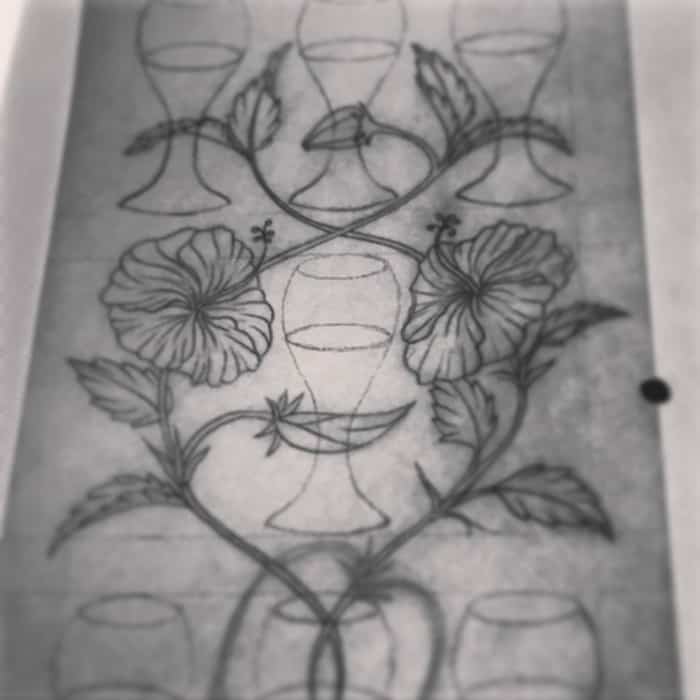
Michael: Arcanum X Tarot is based on the Tarot de Marseille and develops its organic flourishes, integrating them with the traditional objects. This deck is not a restoration, but rather a reworking of the Marseille’s classic forms, combining traditional hand-drawn outlines with modern digital coloring for an effect that, like the foliage making up the designs, grows from the past and links it with the contemporary. The Arcanum X Tarot is currently being created, with a projected release by the end of this year.
—————
Big thanks to all of these busy designers for taking time to share their stories with me. Be sure to pick up their decks and support their work!
Blessings,
Theresa

 I’m Theresa Reed (aka, The Tarot Lady). I’ve been a full-time tarot reader for 30+ years — which, in my industry, makes me pretty badass.
I’m definitely not your average Tarot expert — I drop the F-bomb, I quote rappers, and I’m obsessed with pop culture. Folks come to me for straight-talk + tough-love — without the woo-woo fluff.
I’m Theresa Reed (aka, The Tarot Lady). I’ve been a full-time tarot reader for 30+ years — which, in my industry, makes me pretty badass.
I’m definitely not your average Tarot expert — I drop the F-bomb, I quote rappers, and I’m obsessed with pop culture. Folks come to me for straight-talk + tough-love — without the woo-woo fluff.
You must be logged in to post a comment.